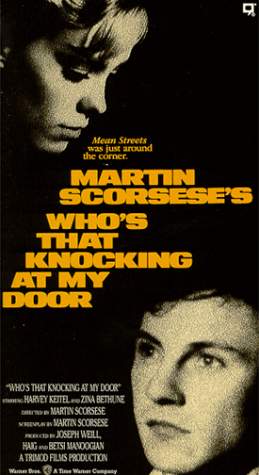
WHO’S THAT KNOCKING AT MY DOOR (I CALL FIRST)
US, 1967, 80 minutes. Black and white.
Harvey Keitel, Zina Bethune, Anne Collette, Lennard Kuras, Michael Scala, Harry Northup, Catherine Scorsese.
Directed by Martin Scorsese.
Who’s That Knocking At My Door was Martin Scorsese’s first film. He made it when he was twenty-five. The film also introduced Harvey Keitel who was aged twenty-eight at this period. They were to work together later in such films as Mean Streets, Taxi Driver and The Last Temptation of Christ.
The film is immediately of interest in showing Martin Scorsese at the beginning of his very successful career. Harvey Keitel also had a successful career (though blighted by drug use in the 1980s). Here he seems to be impersonating Scorsese in his performance.
The film is autobiographical in part. It has the New York Catholic background, the iconography, confession, the issues of premarital sex as well as sexual fantasy. Scorsese is quite explicit especially in his fantasy sex sequences.
The film was also about the mean streets of New York City, the gangs who penalise their enemies and bash them, the hanging out together, the bragging, the talk, the conflicts – and there is one excursion into the countryside, climbing a mountain and admiring the view, quite a contrast with the experience of the city.
Zina Bethune, a dancer and sometime actress, is very good and charming as the girl who is attracted to Keitel’s character, J.R. However, when she explains to Keitel, wanting to be honest, that she had been raped, he reacts very badly, cannot cope with this information and is condemnatory of her. While he does attempt an apology, it is of a macho male who looks down on women, while indulging in his own sexual fantasies.
While Scorsese wrote the screenplay, there is much improvisation. There are also some amusing references for film buffs, especially when J.R. gets to know the girl on the Staten Island ferry and has a long explanation of John Wayne and The Searchers. With reference also to Jeffrey Hunter and King of Kings. There is also talk throughout the film about movies – anticipating something that Quentin Tarantino did in his films of the 1990s.
The film is also a mixture of reality and fantasy and flashback, a juggling with time-frames that was to become popular twenty-five years later.
Scorsese was always devoted to his mother who appeared in some of his films. She appears in the opening sequence, baking a pie for her children.
1. A film of the 1960s, experimental, visual style, 1960s issues, New York, change?
2. The black and white photography, New York City, the Staten Island ferry, restaurants, clubs, apartments, the streets? The contrast with the visit to the mountains?
3. The range of songs, from the period, their use as background commentary, the lyrics? The song of The Doors during the sex sequence? Who’s Knocking At My Door during the religious and confession sequence?
4. Martin Scorsese’s first film, camerawork, editing, the score, performances – and Harvey Keitel like Scorsese in person? The autobiographical themes? The New York Italian? The streets and the bashings? The card-playing? The talk, the brutality? The themes for the movie buffs? Catholicism, icons, confession?
5. J.R. as a Scorsese figure? His age, experience? The opening with the mother, making the food and serving it to the children? The transition to the adults? The initial bashing? J.R. and his friends, Joey, Sally Gaga, Harry? Hanging out, talking, fooling around? Cards and money? Leadership? J.R. as a follower? The narrative of J.R. with his friends – while J.R. daydreamed?
6. J.R. and his being distracted, his dreams, especially about sexuality, explicit? The effect on him? In real life, prudish, shocked with the girl’s confession about the rape, his macho dismissal of her? Wanting to marry her – but not forgiving her? When she had nothing to be forgiven for?
7. His seeing the girl, the Staten Island ferry, the talk, John Wayne and The Searchers, King of Kings, the scenes of Rio Bravo? For film buffs, the picture of ordinary audiences who don’t have this kind of knowledge?
8. The girl, the talk, her background, their going out, talk, liking each other, falling in love, in the room, J.R’s hesitation? Her reaction? Her decision to tell him the story? The visuals of the attack for the audience? J.R. upset, walking out, his return, his apology, yet condemning her, not understanding? Her rejection of his offer of marriage? Her strong character?
9. The women in J.R’s imagination, behaviour, his uninhibited behaviour?
10. The importance of talk, repartee, improvisation? Talk revealing character?
11. Religion, the statues of Mary, the candles and the girl lighting one, the church, the images, confession?
12. The film in the light of Martin Scorsese’s career? Harvey Keitel’s career? 1970s films? And Scorsese’s and Keitel’s actual lives in subsequent decades?